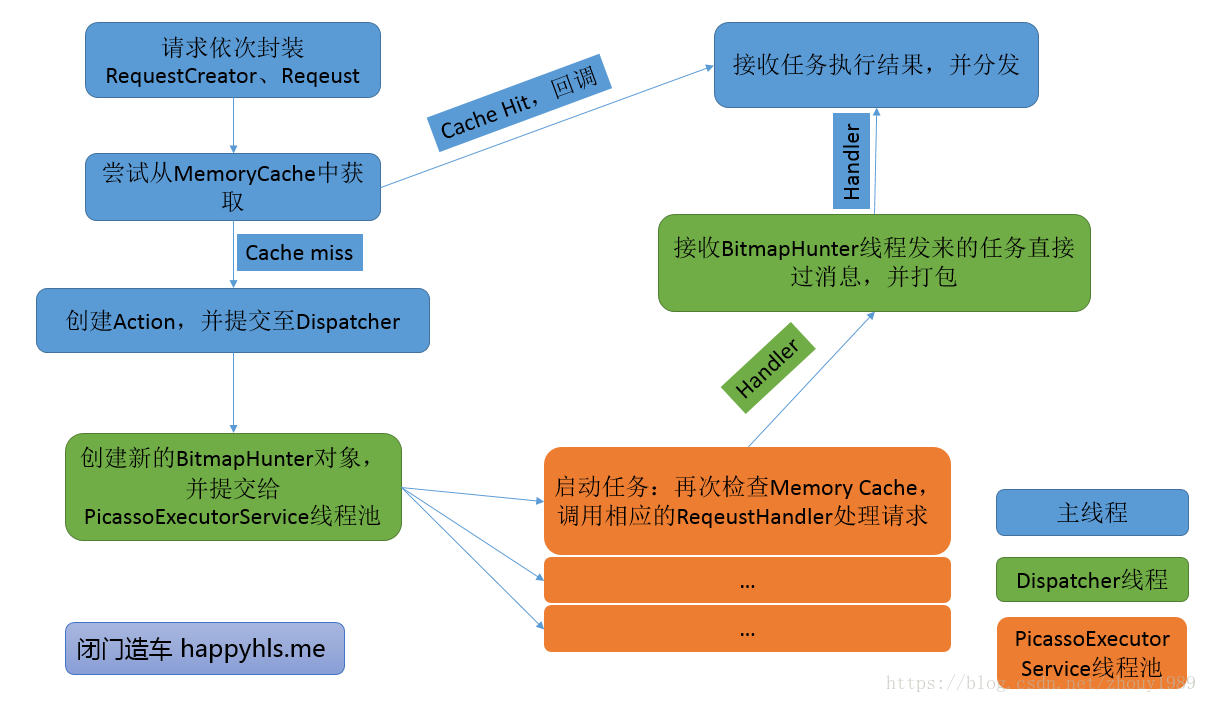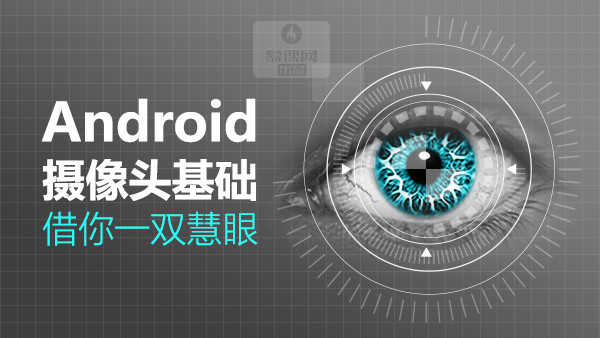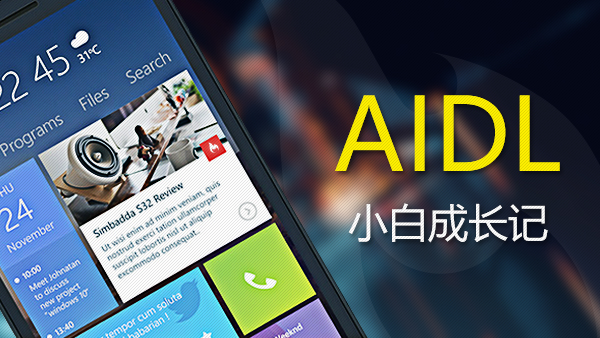接上篇(Android)Picasso图片处理框架简要分析 1
上篇分析到Picasso的into方法,在创建action后,会调用
[java] view plain copy
Action action =
new ImageViewAction(picasso, target, request, memoryPolicy, networkPolicy, errorResId,
errorDrawable, requestKey, tag, callback, noFade);
picasso.enqueueAndSubmit(action);
这里把创建好的action进行提交
[html] view plain copy
void enqueueAndSubmit(Action action) {
Object target = action.getTarget();
if (target != null && targetToAction.get(target) != action) {
// This will also check we are on the main thread.
cancelExistingRequest(target);
targetToAction.put(target, action);
}
submit(action);
}
void submit(Action action) {
dispatcher.dispatchSubmit(action);
}
Dispatcher
Dispatcher是Picasso里非常重要的一个类,在这里面完成了子线程到主线程得到切换
去dispatcher类看看这个方法,使用handler发送一个消息到dispatcherThread线程,这个是一个继承于HandlerThread,这个大家都熟悉吧,是自带lopper的thread
[java] view plain copy
void dispatchSubmit(Action action) {
handler.sendMessage(handler.obtainMessage(REQUEST_SUBMIT, action));
}
这个handler是个DispatcherHandler,是dispatcher里的一个静态内部类,这是dispatcher里的子线程handler
[java] view plain copy
DispatcherHandler(Looper looper, Dispatcher dispatcher) {
super(looper);
this.dispatcher = dispatcher;
}
除此之外,还有一个主线程handler
[java] view plain copy
this.mainThreadHandler = mainThreadHandler;
这个handler实在Picasso类中传入的
[java] view plain copy
static final Handler HANDLER = new Handler(Looper.getMainLooper())
[java] view plain copy
Dispatcher dispatcher = new Dispatcher(context, service, HANDLER, downloader, cache, stats);
ok,接着看dispatchSubmit,最终会调用到这里
void performSubmit(Action action, boolean dismissFailed) {
if (pausedTags.contains(action.getTag())) {
pausedActions.put(action.getTarget(), action);
if (action.getPicasso().loggingEnabled) {
log(OWNER_DISPATCHER, VERB_PAUSED, action.request.logId(),
"because tag '" + action.getTag() + "' is paused");
}
return;
}
BitmapHunter hunter = hunterMap.get(action.getKey());
if (hunter != null) {
hunter.attach(action);
return;
}
if (service.isShutdown()) {
if (action.getPicasso().loggingEnabled) {
log(OWNER_DISPATCHER, VERB_IGNORED, action.request.logId(), "because shut down");
}
return;
}
hunter = forRequest(action.getPicasso(), this, cache, stats, action);
hunter.future = service.submit(hunter);
hunterMap.put(action.getKey(), hunter);
if (dismissFailed) {
failedActions.remove(action.getTarget());
}
if (action.getPicasso().loggingEnabled) {
log(OWNER_DISPATCHER, VERB_ENQUEUED, action.request.logId());
}
}
首先检查这个action是否在pausedTags这个列表当中,pausedTags是一个set集合,用来记录暂停任务的列表。如它在列表中,则放入pausedActions列表中,以便到时唤醒请求。
如不在列表中,则创建BitmapHunter这个runnable,然后调用attach方法,将Action加入action list这个列表中,然后return
如hunterMap中没有这个hunter,会创建BitmapHunter,提交到到service线程池,然后将hunter放到hunterMap这个集合中。 线程池的执行过程,其实就是执行hunt方法,这在上篇文章中已经分析过了,就是命中缓存或者在NetworkRequestHandler调用okhttp下载图片(如果没有okhttp,则用UrlConnection)。
Bitmap hunt() throws IOException {
Bitmap bitmap = null;
if (shouldReadFromMemoryCache(memoryPolicy)) {
bitmap = cache.get(key);
if (bitmap != null) {
stats.dispatchCacheHit();
loadedFrom = MEMORY;
if (picasso.loggingEnabled) {
log(OWNER_HUNTER, VERB_DECODED, data.logId(), "from cache");
}
return bitmap;
}
}
networkPolicy = retryCount == 0 ? NetworkPolicy.OFFLINE.index : networkPolicy;
RequestHandler.Result result = requestHandler.load(data, networkPolicy);
if (result != null) {
loadedFrom = result.getLoadedFrom();
exifOrientation = result.getExifOrientation();
bitmap = result.getBitmap();
// If there was no Bitmap then we need to decode it from the stream.
if (bitmap == null) {
Source source = result.getSource();
try {
bitmap = decodeStream(source, data);
} finally {
try {
//noinspection ConstantConditions If bitmap is null then source is guranteed non-null.
source.close();
} catch (IOException ignored) {
}
}
}
}
if (bitmap != null) {
if (picasso.loggingEnabled) {
log(OWNER_HUNTER, VERB_DECODED, data.logId());
}
stats.dispatchBitmapDecoded(bitmap);
if (data.needsTransformation() || exifOrientation != 0) {
synchronized (DECODE_LOCK) {
if (data.needsMatrixTransform() || exifOrientation != 0) {
bitmap = transformResult(data, bitmap, exifOrientation);
if (picasso.loggingEnabled) {
log(OWNER_HUNTER, VERB_TRANSFORMED, data.logId());
}
}
if (data.hasCustomTransformations()) {
bitmap = applyCustomTransformations(data.transformations, bitmap);
if (picasso.loggingEnabled) {
log(OWNER_HUNTER, VERB_TRANSFORMED, data.logId(), "from custom transformations");
}
}
}
if (bitmap != null) {
stats.dispatchBitmapTransformed(bitmap);
}
}
}
return bitmap;
}
hunt方法执行完毕后,会返回Bitmap,在Bitmap Hunter的run方法中,会得到这个结果
@Override public void run() {
try {
updateThreadName(data);
if (picasso.loggingEnabled) {
log(OWNER_HUNTER, VERB_EXECUTING, getLogIdsForHunter(this));
}
result = hunt();
if (result == null) {
dispatcher.dispatchFailed(this);
} else {
dispatcher.dispatchComplete(this);
}
} catch (NetworkRequestHandler.ResponseException e) {
if (!NetworkPolicy.isOfflineOnly(e.networkPolicy) || e.code != 504) {
exception = e;
}
dispatcher.dispatchFailed(this);
} catch (IOException e) {
exception = e;
dispatcher.dispatchRetry(this);
} catch (OutOfMemoryError e) {
StringWriter writer = new StringWriter();
stats.createSnapshot().dump(new PrintWriter(writer));
exception = new RuntimeException(writer.toString(), e);
dispatcher.dispatchFailed(this);
} catch (Exception e) {
exception = e;
dispatcher.dispatchFailed(this);
} finally {
Thread.currentThread().setName(Utils.THREAD_IDLE_NAME);
}
}
上述代码可以看到,会对result进行判断,然后走到dispatcher中的相应回调方法
void dispatchComplete(BitmapHunter hunter) {
handler.sendMessage(handler.obtainMessage(HUNTER_COMPLETE, hunter));
}
看看这个handler做了什么
case HUNTER_COMPLETE: {
BitmapHunter hunter = (BitmapHunter) msg.obj;
dispatcher.performComplete(hunter);
break;
}
看performComplete
void performComplete(BitmapHunter hunter) {
if (shouldWriteToMemoryCache(hunter.getMemoryPolicy())) {
cache.set(hunter.getKey(), hunter.getResult());
}
hunterMap.remove(hunter.getKey());
batch(hunter);
if (hunter.getPicasso().loggingEnabled) {
log(OWNER_DISPATCHER, VERB_BATCHED, getLogIdsForHunter(hunter), "for completion");
}
}
首先,根据条件进行缓存写入,然后在hunterMap中remove这个hunter,然后调用batch方法
private void batch(BitmapHunter hunter) {
if (hunter.isCancelled()) {
return;
}
if (hunter.result != null) {
hunter.result.prepareToDraw();
}
batch.add(hunter);
if (!handler.hasMessages(HUNTER_DELAY_NEXT_BATCH)) {
handler.sendEmptyMessageDelayed(HUNTER_DELAY_NEXT_BATCH, BATCH_DELAY);
}
}
我们关注下面,发了一个空消息给子线程handler
case HUNTER_DELAY_NEXT_BATCH: {
dispatcher.performBatchComplete();
break;
}
然后继续看
void performBatchComplete() {
List<BitmapHunter> copy = new ArrayList<>(batch);
batch.clear();
mainThreadHandler.sendMessage(mainThreadHandler.obtainMessage(HUNTER_BATCH_COMPLETE, copy));
logBatch(copy);
}
终于完成了,这边给主线程handler发送了消息,并且清除了batch list,这个handler在Picasso这个类中
case HUNTER_BATCH_COMPLETE: {
@SuppressWarnings("unchecked") List<BitmapHunter> batch = (List<BitmapHunter>) msg.obj;
//noinspection ForLoopReplaceableByForEach
for (int i = 0, n = batch.size(); i < n; i++) {
BitmapHunter hunter = batch.get(i);
hunter.picasso.complete(hunter);
}
break;
}
然后会调用到
private void deliverAction(Bitmap result, LoadedFrom from, Action action, Exception e) {
if (action.isCancelled()) {
return;
}
if (!action.willReplay()) {
targetToAction.remove(action.getTarget());
}
if (result != null) {
if (from == null) {
throw new AssertionError("LoadedFrom cannot be null.");
}
action.complete(result, from);
if (loggingEnabled) {
log(OWNER_MAIN, VERB_COMPLETED, action.request.logId(), "from " + from);
}
} else {
action.error(e);
if (loggingEnabled) {
log(OWNER_MAIN, VERB_ERRORED, action.request.logId(), e.getMessage());
}
}
}
执行了action的complete方法,可以在ImageViewAction看实现
@Override public void complete(Bitmap result, Picasso.LoadedFrom from) {
if (result == null) {
throw new AssertionError(
String.format("Attempted to complete action with no result!\n%s", this));
}
ImageView target = this.target.get();
if (target == null) {
return;
}
Context context = picasso.context;
boolean indicatorsEnabled = picasso.indicatorsEnabled;
PicassoDrawable.setBitmap(target, context, result, from, noFade, indicatorsEnabled);
if (callback != null) {
callback.onSuccess();
}
}
最后在PicassoDrawable对ImageView设置了图片,这样图片就设置完成了。
static void setBitmap(ImageView target, Context context, Bitmap bitmap,
Picasso.LoadedFrom loadedFrom, boolean noFade, boolean debugging) {
Drawable placeholder = target.getDrawable();
if (placeholder instanceof Animatable) {
((Animatable) placeholder).stop();
}
PicassoDrawable drawable =
new PicassoDrawable(context, bitmap, placeholder, loadedFrom, noFade, debugging);
target.setImageDrawable(drawable);
}
总结一下整个流程
Picasso.get().load("http://i.imgur.com/DvpvklR.png").into(imageView);1.load方法中会创建RequestCreator,设置图片的基本信息,placeholder,error等
2.into方法会在dispatcher中进行请求管理,测试缓存命中,没有命中则创建action,包装请求,然后提交action到线程池,然后创建hunter对象,它是一个runnable,在run方法中会调用hunt方法。在hunt方法中再次测试缓存,如未命中则去NetworkRequestHandler中进行网络请求下载图片。
3.得到图片后设置图片到Imageview
最后,盗图一张总结


 随时随地看视频
随时随地看视频




